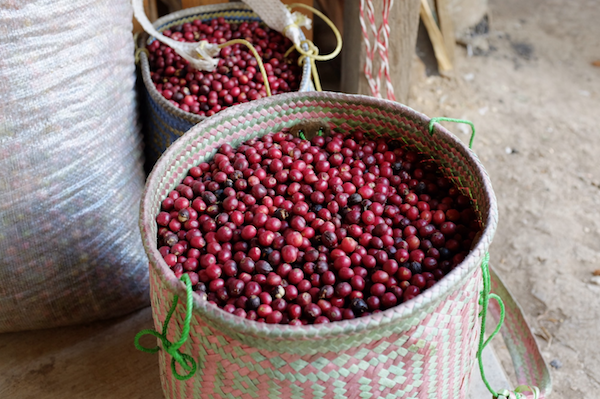Standing out of the way in the Roman-Lopez family’s courtyard, we watched quietly and learned how locals near Teojomulco, Oaxaca practice delivering and receiving coffee. The Roman-Lopez’s courtyard functions as the local bodega (warehouse) where small scale growers bring their coffee already dried in parchment, which is weighed on arrival and paid for by the Roman-Lopez’s who eventually pool tiny local lots together and handle the next stage of transportation to dry milling.
Read MoreWe’re pleased to release our lot from the Sierra Mixteca Cooperative this week, despite unforeseen delays in its arrival to the US. This February, 2018, Christina Chin and I had the pleasure of visiting with this group of small producers who were finishing their harvest for the year, which helps us paint a clearer picture of this coffee’s story.
Sierra Mixteca is a mountain range situated in the northern part of Oaxaca, and this coffee comes directly from the community of in the smaller region of Yucihiti. The Mixtec people are one of the dozens of culturally distinct indigenous communities living predominantly in Oaxaca, Guerrero, and Puebla states. In the town of Miramar, Yucihiti, the Cooperativo Sierra Mixteca was formed in 2012 to provide local farmers with better leverage in the export market. It also enables them to centralize aspects of processing, transportation, and storage, as well as providing them with extra access to financing.
Made up of 140 members, most of these farmers operate very small farms of .5–3 hectares, where the vast majority of labor is performed by the farming families with little to no additional workers. They are committed to Organic farming. We visited with two such families who we’re profiling here.
Read MoreTerroir: Characteristics which correlate to the soil where a coffee grew. There is a wide range of specificity here. Terroir characteristics can be thought of as broadly as “A Brazilian profile has low acidity and tastes malty” — or — as specifically “this part of a farm has slightly different soil composition, and tastes different than another part of the farm planted with the same varietal.” Somewhere in the middle it’s probably most relevant to be able to identify different regional profiles within a country to understand and appreciate just how vast the endless variety of tastes can go when talking about terroir.
Varietal: The taxonomic classification after species. Coffee has two species, Robusta and Arabica. Coffee varietals can be thought of as stemming from the heirloom varietal(s) growing in western Ethiopia. Over time through natural mutation, natural selection, and deliberate hybridization, the number of varietals increased. Currently the number of coffee varietals is expanding rapidly as farmers continue to experiment and hybridize. Read more about specific varietal tastes here.
Species: There are two species of the genus Coffea, called Coffea Arabica and Coffea Canephora — more commonly called, Robusta. There are many varietals which descend from both species. Robusta is more productive and disease resistant, with less pleasant taste and high caffeine content.
Read MoreProducer: Nicholas Hammond
Region: San Martin Jilotepeque, Chimaltenango, Guatemala
MARCH 2018
Returning to Catalan De Las Mercedes this year, I was most struck by the expansive efforts of Nico Hammond over the last year. The farm’s robust, four year-old wet mill dominates the bottom of a slope facing the farmhouse. Above it, farther up the hill, you catch a glimpse of the top of the farm, which largely faces west. Only 32 hectares of 300 hectares are planted at the moment, and with over 80,000 young trees nearly ready to plant, Nico’s plans for the future are easy to grasp. The farm traditionally grows Red & Yellow Bourbons, but in the nursery you’ll find Pacamara, Maragogipe, and Geisha as well, which reflect evolving tastes and wisely cautious planning. All three are roya resistant, with Pacamara and Geisha known for exciting profiles and high cupping scores.
Read More




